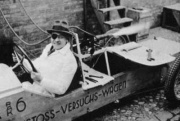Walter J.H. Riedel
From The Space Library
Walter "Papa" Riedel was born in 1903 in Berlin Germany. In 1927 he joined the A.G. Fuer Industriegasverwertung as a designer and engineer. He was assigned by his boss, Paul Heylandt, to be an assistant to the early rocket pioneer Max Valier, a role which he took from later 1929 until Valier's death in May 1930.
During those few months Riedel worked side by side with Valier as he created ever more powerful liquid fuel rocket engines. Over a four day period at the end of January 1930 Valier's engine increased in thrust from 300gm to 2,150gm. After a brief interlude Valier and Riedel increased the thrust in March 1930 to 8,000gm. On March 22nd 1930 the engine was installed in Valier's experimental rocket car the Rak 6, which was renamed the Rak 7. Valier was able to drive the car around a track for 22 minutes. By April 14th the engine was putting out 28kg thrust. The car was put around a test track for nearly 10 minutes and Riedel later wrote, "April 17 and 19 1930...These dates should be noted because they are of some historic importance. Indeed, it was the first time that a rocket propulsion with liquid propellants was demonstrated in Germany..."
On May 17th 1930 Riedel was operating the valves on an engine test using kerosene as the fuel. The kerosene and liquid oxygen created a slurry in the engine nozzle and when the gelatinous mixture fell into the exhaust the engine exploded. Valier was mortally wounded and Riedel could do nothing more than catch him as he fell. Rocketry had taken its first victim.
In 1931 or 1932 Riedel and his partner Arthur Rudolph proposed and then built regenerative cooling for rocket engines. In 1934 his rocket group caught the attention of future head of Peenemunde Walter Dornberger and was amalgamated with that of Wernher von Braun at Kummersdorf. In 1937 Riedel became chief designer of the V-2 missile. In October 1942 he became Chief engineer on the V-2 production.
On May 14th 1945 Riedel was located in a jail cell in Saalfeld where he was being held by U.S. Counter Intelligence. Some local people had directed the Americans to Riedel and accused him of making a bacteriological weapon. When Riedel tried to explain to his interrogators that what they were looking at was a valve for a surface to air missile they didn't believe him. When he lost his temper he was roughed up.
In March 1947 he was relocated to the Royal Aircraft Establishment at Farnborough England before moving to the associated Rocket Propulsion Establishment at Westcott in Buckinghamshire. He remained working there until his death in 1968. He died in Berlin on May 15th 1968. In his obituary in the Journal of the British Interplanetary Society it was reported that he worked on both liquid and solid fuel rockets at Westcott. It is believed that Riedel never travelled to the United States but he was often mistaken for Walther Riedel, another rocket pioneer who also worked on the V-2 before moving to California to work for North American Aviation.
It is believed that Riedel became a member of the VfR. In 1953 he wrote of his experiences with Valier in an article for the journal Weltraumfahrt. His memoirs from 1930 to 1942 were translated into English in 2005 and published by the Rolls Royce Historical Society.

